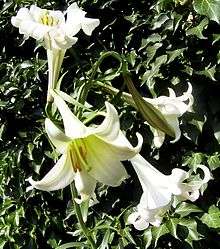Lilium philippinense
| Benguet lily | |
|---|---|
 | |
| Scientific classification | |
| Kingdom: | Plantae |
| (unranked): | Angiosperms |
| (unranked): | Monocots |
| Order: | Liliales |
| Family: | Liliaceae |
| Genus: | Lilium |
| Species: | L. philippinense |
| Binomial name | |
| Lilium philippinense[1] Baker | |
| Synonyms[2] | |
| |
Lilium philippinense, commonly known as the Benguet lily,[3] or Philippine lily,[4] is a lily, native to Taiwan and to the Cordillera region, primarily to the province of Benguet, in the northern Philippines.[2][5]
Description
The plant's flowers are white trumpet-shaped, known to emit a fragrant odor.[3][6][7]
Conservation status
Lilium philippinense is endangered and is known to thrive only in high altitudes of the Cordillera Central mountains. In August 2013, the Baguio City Environment and Parks Management Office personnel had successfully raised the lilies for six months at the city's Botanical Garden.[6]
References
- ↑ "Species details: Accepted scientific name: Lilium philippinense Baker (accepted name)". Catalogue of Life. Retrieved 10 February 2015.
- 1 2 Kew World Checklist of Selected Plant Families
- 1 2 "Lilium philippinense (Benguet lily)". Shoot Limited. Retrieved 10 February 2015.
- ↑ "Lilium philippinense". Natural Resources Conservation Service PLANTS Database. USDA. Retrieved 21 June 2015.
- ↑ Baker, John Gilbert 1873. Gardeners' Chronicle & Agricultural Gazette 1873: 1141 short description in Latin, longer description and commentary in English, line drawing of flower and leaves of Lilium philippinense
- 1 2 "Park personnel rear vanishing Benguet lily". Sun.Star Baguio. 13 August 2013. Retrieved 10 February 2015.
- ↑ Van Steenis, C.G.G.J. (ed.) (1979-1983). Flora Malesiana 9: 1-600. Noordhoff-Kolff N.V., Djakarta.
This article is issued from Wikipedia - version of the 6/22/2015. The text is available under the Creative Commons Attribution/Share Alike but additional terms may apply for the media files.